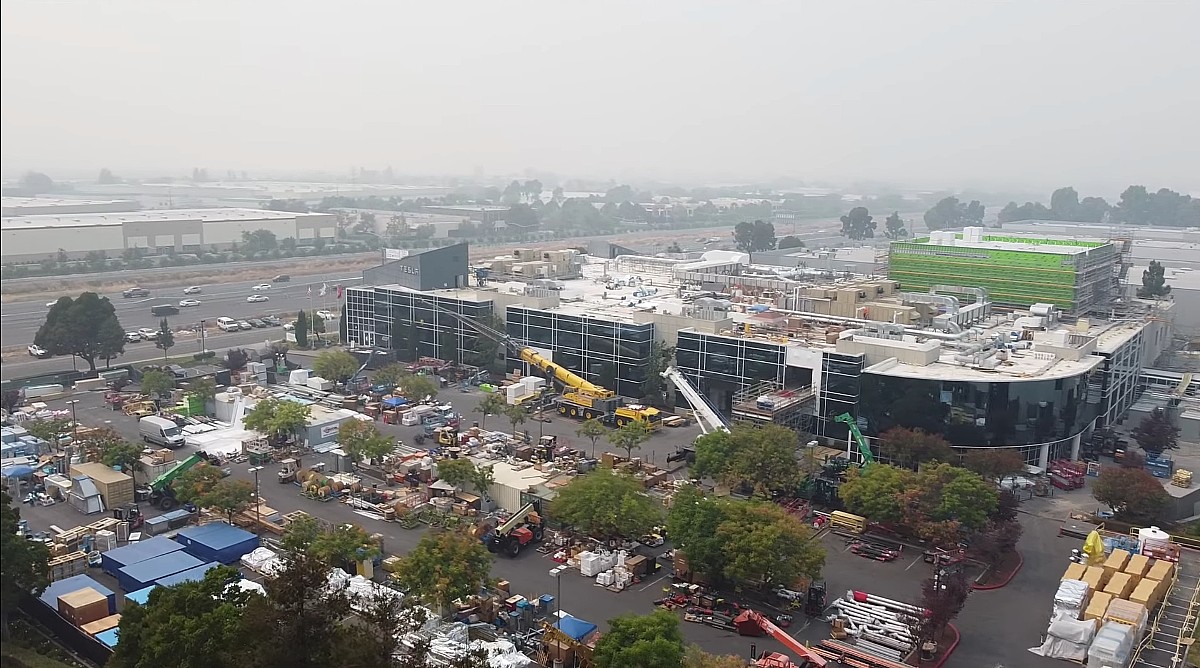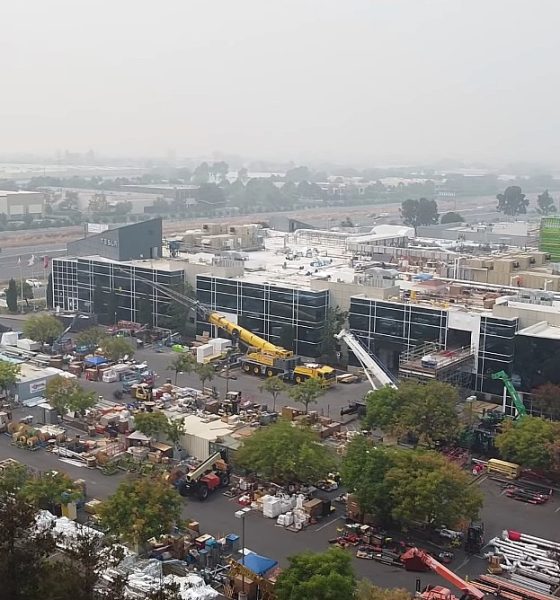

News
Tesla’s ‘Roadrunner’ cell production facility is taking form ahead of Battery Day
Tesla’s Battery Day is only a few weeks away, and as the electric vehicle community eagerly waits for the highly-anticipated event, the company’s pilot battery production line appears to be well on its way to being completed, and perhaps even ramped. This was hinted at by a recent drone flyover of Tesla’s building at Kato Road, located close to the company’s Fremont factory.
Footage taken by a Tesla enthusiast who runs the Living with Intent channel on YouTube shows that the expansion of the Kato Road facility is well on its way. Based on the short video taken of the site, it appears that much work is being done inside the building, as hinted at by the massive amount of materials that are seemingly waiting to be taken inside the facility. The extra floor that Tesla has been constructing is also showing progress since it was initially photographed early last month.
Tesla is a disruptive company that moves fast, and thus, sightings of facilities with ongoing improvements are not really new. However, the Kato Road building is quite unique in the way that it is expected to house the pilot line for Tesla’s own battery production system. Elon Musk has been pretty open about his enthusiasm for Battery Day, stating that the event will likely blow people’s minds. At the same time, the CEO also suggested that the event will include a tour of Tesla’s in-house battery cell production setup.
This cell production system is the first of its kind, as Tesla has partnered with other battery firms in the past. Panasonic is a key partner in Gigafactory Nevada, while LG Chem and CATL are partners for Gigafactory Shanghai. But while Tesla reportedly continues to work with its partners to make better batteries, the company is also hard at work developing its own cell production capabilities. This was hinted at during the 2019 Annual Shareholder Meeting, when company executives described the effort as a step towards Tesla becoming the master of its own “destiny.”
Filings to the City of Fremont suggest that Tesla’s Kato Road facilities will be utilized for the “Roadrunner” project, which refers to the company’s own custom battery cell production line. Tesla’s “Roadrunner” cells have not been discussed in depth by the company yet, but speculations and reports suggest that the batteries are next-generation lithium-ion cells that are capable of lasting a million miles. Such batteries could make a big difference for Tesla’s flagship products like the Plaid Model S and the Megapack.
Once completed, the Kato Road facility is expected to house about 45 research and development employees and up to 425 manufacturing workers that are spread through several shifts from Monday to Friday. This may allow the pilot cell production line to produce enough batteries for low-volume vehicles, perhaps like the Plaid Model S and the new Roadster. Tesla has since opened a number of job openings related to cell manufacturing that are seemingly for the Kato Road location as well. Among these job listings are Cell Engineers, Production Process Engineers, and Controls Engineers, all of which were listed as based in Fremont, California.
Watch a recent footage of Tesla’s “Roadrunner” site in the video below.
H/T JPR007.

News
Tesla FSD fleet is nearing 7 billion total miles, including 2.5 billion city miles
As can be seen on Tesla’s official FSD webpage, vehicles equipped with the system have now navigated over 6.99 billion miles.

Tesla’s Full Self-Driving (Supervised) fleet is closing in on almost 7 billion total miles driven, as per data posted by the company on its official FSD webpage.
These figures hint at the massive scale of data fueling Tesla’s rapid FSD improvements, which have been quite notable as of late.
FSD mileage milestones
As can be seen on Tesla’s official FSD webpage, vehicles equipped with the system have now navigated over 6.99 billion miles. Tesla owner and avid FSD tester Whole Mars Catalog also shared a screenshot indicating that from the nearly 7 billion miles traveled by the FSD fleet, more than 2.5 billion miles were driven inside cities.
City miles are particularly valuable for complex urban scenarios like unprotected turns, pedestrian interactions, and traffic lights. This is also the difference-maker for FSD, as only complex solutions, such as Waymo’s self-driving taxis, operate similarly on inner-city streets. And even then, incidents such as the San Francisco blackouts have proven challenging for sensor-rich vehicles like Waymos.
Tesla’s data edge
Tesla has a number of advantages in the autonomous vehicle sector, one of which is the size of its fleet and the number of vehicles training FSD on real-world roads. Tesla’s nearly 7 billion FSD miles then allow the company to roll out updates that make its vehicles behave like they are being driven by experienced drivers, even if they are operating on their own.
So notable are Tesla’s improvements to FSD that NVIDIA Director of Robotics Jim Fan, after experiencing FSD v14, noted that the system is the first AI that passes what he described as a “Physical Turing Test.”
“Despite knowing exactly how robot learning works, I still find it magical watching the steering wheel turn by itself. First it feels surreal, next it becomes routine. Then, like the smartphone, taking it away actively hurts. This is how humanity gets rewired and glued to god-like technologies,” Fan wrote in a post on X.
News
Tesla starts showing how FSD will change lives in Europe
Local officials tested the system on narrow country roads and were impressed by FSD’s smooth, human-like driving, with some calling the service a game-changer for everyday life in areas that are far from urban centers.

Tesla has launched Europe’s first public shuttle service using Full Self-Driving (Supervised) in the rural Eifelkreis Bitburg-Prüm region of Germany, demonstrating how the technology can restore independence and mobility for people who struggle with limited transport options.
Local officials tested the system on narrow country roads and were impressed by FSD’s smooth, human-like driving, with some calling the service a game-changer for everyday life in areas that are far from urban centers.
Officials see real impact on rural residents
Arzfeld Mayor Johannes Kuhl and District Administrator Andreas Kruppert personally tested the Tesla shuttle service. This allowed them to see just how well FSD navigated winding lanes and rural roads confidently. Kruppert said, “Autonomous driving sounds like science fiction to many, but we simply see here that it works totally well in rural regions too.” Kuhl, for his part, also noted that FSD “feels like a very experienced driver.”
The pilot complements the area’s “Citizen Bus” program, which provides on-demand rides for elderly residents who can no longer drive themselves. Tesla Europe shared a video of a demonstration of the service, highlighting how FSD gives people their freedom back, even in places where public transport is not as prevalent.
What the Ministry for Economic Affairs and Transport says
Rhineland-Palatinate’s Minister Daniela Schmitt supported the project, praising the collaboration that made this “first of its kind in Europe” possible. As per the ministry, the rural rollout for the service shows FSD’s potential beyond major cities, and it delivers tangible benefits like grocery runs, doctor visits, and social connections for isolated residents.
“Reliable and flexible mobility is especially vital in rural areas. With the launch of a shuttle service using self-driving vehicles (FSD supervised) by Tesla in the Eifelkreis Bitburg-Prüm, an innovative pilot project is now getting underway that complements local community bus services. It is the first project of its kind in Europe.
“The result is a real gain for rural mobility: greater accessibility, more flexibility and tangible benefits for everyday life. A strong signal for innovation, cooperation and future-oriented mobility beyond urban centers,” the ministry wrote in a LinkedIn post.
News
Tesla China quietly posts Robotaxi-related job listing
Tesla China is currently seeking a Low Voltage Electrical Engineer to work on circuit board design for the company’s autonomous vehicles.

Tesla has posted a new job listing in Shanghai explicitly tied to its Robotaxi program, fueling speculation that the company is preparing to launch its dedicated autonomous ride-hailing service in China.
As noted in the listing, Tesla China is currently seeking a Low Voltage Electrical Engineer to work on circuit board design for the company’s autonomous vehicles.
Robotaxi-specific role
The listing, which was shared on social media platform X by industry watcher @tslaming, suggested that Tesla China is looking to fill the role urgently. The job listing itself specifically mentions that the person hired for the role will be working on the Low Voltage Hardware team, which would design the circuit boards that would serve as the nervous system of the Robotaxi.
Key tasks for the role, as indicated in the job listing, include collaboration with PCB layout, firmware, mechanical, program management, and validation teams, among other responsibilities. The role is based in Shanghai.
China Robotaxi launch
China represents a massive potential market for robotaxis, with its dense urban centers and supportive policies in select cities. Tesla has limited permission to roll out FSD in the country, though despite this, its vehicles have been hailed as among the best in the market when it comes to autonomous features. So far, at least, it appears that China supports Tesla’s FSD and Robotaxi rollout.
This was hinted at in November, when Tesla brought the Cybercab to the 8th China International Import Expo (CIIE) in Shanghai, marking the first time that the autonomous two-seater was brought to the Asia-Pacific region. The vehicle, despite not having a release date in China, received a significant amount of interest among the event’s attendees.








